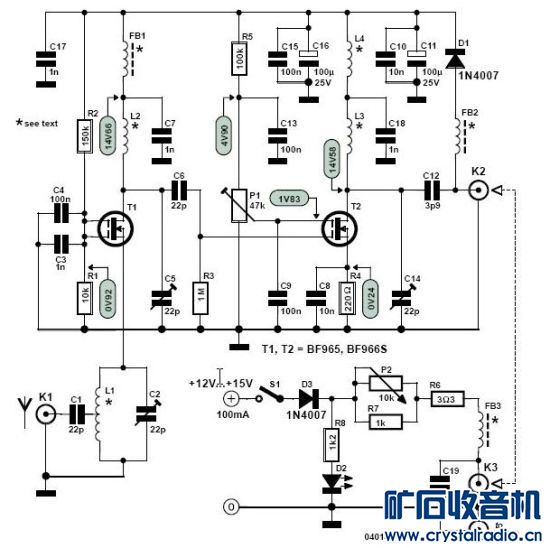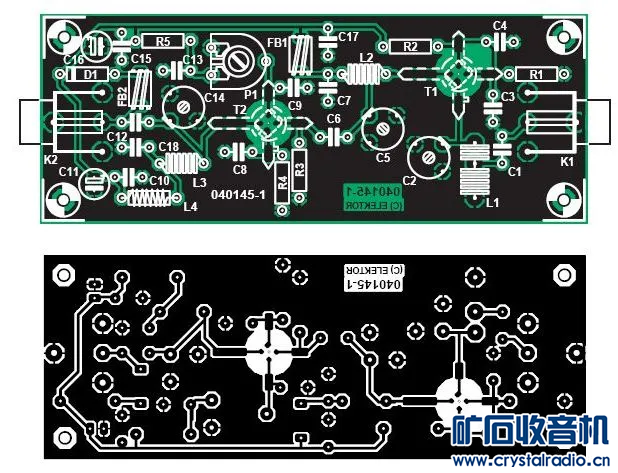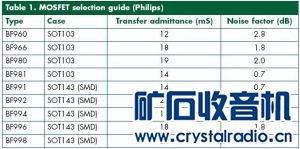|
|
是一个老外的。
VHF FM Antenna Booster Circuit
Together with a good directional antenna this high performance two-stage antenna amplifier for the VHF FM broadcast band will enable you to capture far removed (DX) stations. Alternatively, it will drastically improve reception of FM signals you’ve come to accept as marginal and noisy in your area.
Together with a good directional antenna this high performance two-stage antenna amplifier for the VHF FM broadcast band will enable you to capture far removed (DX) stations. Alternatively, it will drastically improve reception of FM signals you’ve come to accept as marginal and noisy in your area.
FM/VHF antenna amplifier circuit schematic

For various reasons, an increasing number of people are not satisfied with the quality of radio signals that can be received via cable systems. Unfortunately, cross-modulation, and other nasty effects created in the head end station are in stark contrast with the superb quality of high-end FM tuners that can be bought commercially.
Not surprisingly, owners of such tuners will often prefer to have their own antenna on the roof. Add to that a high-performance FM antena booster like the one described here and you can start DXing as well as enjoying high-quality stereo reception. The author employs the present amplifier in combination with a Sangean ATS-803 World band receiver, a Philips RR-571 tuner and a single-element cubical quad directional antenna at a height of just 15 feet. Using this setup he is able to receive FM stations as far off as 500 km.
Antenna booster circuit description
In the design we’re about to describe you’ll find the following important parameters coupled: low noise figure (approx. 1 dB); high gain (up to 40 dB) and low susceptibility to intermodulation products. Yet the amplifier is inexpensive and easy to build. The circuit diagram in Figure 1 reveals the secret: dual-gate MOSFETs in positions T1 and T2. The first of these, T1, is configured mainly for low noise and antenna matching and the second, T2, for high gain. Unusually, the antenna signal is applied to T1 via its source (S) terminal, which is convenient because unlike one of the gates (G1 and G2) it already represents a fairly low impedance. None the less, for impedance matching with the 50 Ω coax cable a tap needs to be used on tuned filter L1/C2.
For VHF and UHF amplifiers, DG-MOSFETs represent a good alternative to cheap but noisy bipolar transistors and very expensive and difficult to get Ga-As FETs.
The gain of the second DG-MOSFET in the circuit is adjustable using preset P1 which varies the bias voltage to T2’s G2 terminal — this is the classic way of controlling the gain of a DGMOSFET and it still works very well. Such a control is included in the design to allow you to get the exact amount of gain required for your particular application. For example, if you live near a powerful VHF FM or TV broadcast transmitter then you’ll find that a lot of gain produces cross-modulation and other unwanted effects like coupled oscillation and ‘birdies’ within the FM band.
For stability the supply voltage is decoupled at several locations by electrolytic capacitors and ceramic capacitors for the low and high frequencies respectively. To enable it to be mounted as close as possible to the antenna, the amplifier is powered via the download coax cable, i.e., over coax connectors connected to K2 and K3. In the supply, the RF signal is taken off the coax core by capacitor C19.
The supply voltage is adjustable to some extent with pot P2, which will also allow a degree of gain control. The current through ‘power on’ LED D2 should be about 10 mA. If a low-current LED is used, then R8 has to be increased accordingly. With electrical safety in mind we strongly suggest the use of a mains adapter with 12 VDC output. Depending on the gain set and the DG-MOSFETs used the circuit will consume about 50 mA so a 100-mA or slightly more powerful adapter will be fine in most cases.
VHF FM antenna amplifier construction
The amplifier is built on the singlesided printed circuit board shown in Figure 2. The inductors in the design are all very simple to make, see the parts list for construction details. L1, L2 and L3, are wound on a 4.5-mm dia. drill or pencil. L1 then needs to be stretched to a length of about 10 mm. You’ll find that a relatively large resistor is needed to wind choke L4 on — we used a 0.5-watt carbon-film resistor from the junkbox (metal film resistors seem to have taken over completely). The value 1 MΩ is uncritical, what we’re after is ‘a lot’ of carbon for the core so 820 k or 1.2 M will do just as well.
FM antenna booster PCB layout

The DG-MOSFETs are not only sensitive to static discharges but also easy to fit the wrong way around. The non-SMD versions require 5-mm holes t be drilled in the PCB. Make absolutely sure you know each MOSFET’s final orientation on the board before soldering it in place — check, think hard and refer to the component drawing shown in Figure 1. You may find that the legs are a bit too long for the PCB but don’t use your cutters until the very last moment because without the stud marker (source terminal) you will be lost for device orientation.

Several VHF/UHF DG-MOSFETs may be used in this circuit — see Table 1. With some dexterity it is also possible to use SMD devices. In general, you should aim to use a BF9xx with a low noise figure, although that may imply a slightly reduced overall gain. Remember, however, that the amplifier’s gain is secondary to the noise figure — in practice, any gain between 25 dB and 40 dB will be just fine.
The power supply parts are not accommodated on a PCB but may be connected up using flying lead construction in a small case. The finished PC should be cleaned with isopropyl alcohol to remove solder residu.
The amplifier must be housed in a metal case with proper coax connectors used for K1 and K2. The author used F-type sockets as customary with satellite TV rigs. They are cheap and easy to obtain. However, BNC sockets may be used equally well. The connections between the sockets and the amplifier input and output should be kept as short as possible using thin coax cable like RG174/U.
VHF Antenna Setting up
Give the PCB a final, thorough inspection for bad soldering, wrong components, etc., and resolve all problems before proceeding.
Set all presets and trimmers to the centre of their travel. Apply power to the amplifier and check the various test voltages indicated in the circuit diagram. These voltages are typical and should not be taken to mean the ‘law’. Tune your VHF FM radio to a weak signal at around 98 MHz. Tune the amplifier back to front, that is, first C14, then C5 and then C2 for best reception — your ears and the tuner’s S meter will tell you what’s happening. If necessary reduce or increase the gain using P1. A good way to simulate a weak signal is to turn the antenna away from the transmitter direction.
The amplifier’s 3-dB bandwidth will be about 10 MHz with all tuned elements at the centre frequency. By careful retuning of the three trimmer capacitors (‘staggering’), this may be widened to 20-25 MHz at the cost of some gain. Fine tuning may also be achieved by stretching or compressing the three air-spaced inductors. This method may be for specialists only, however.
Other bands
The amplifier may be modified for use at slightly higher frequencies like 120 MHz (VHF airband), 145 MHz (2-m radio amateur band or even 146- 174 MHz (PMR band). Some experience may be required in tweaking the inductors for resonance at their new frequency however. If you find that a particular trimmer no longer ‘peaks’ then the L/C combination is out of range. Lacking specialised test equipment like a grid dipper to see where it does resonate, go for trial and error by fitting an inductor with fewer turns and see what happens then. Whatever the frequency, the booster will not fail to give the kiss of life to a duff receiver.
COMPONENTS LIST
Resistors:
R1 = 10kΩ
R2 = 150kΩ
R3 = 1MΩ
R4 = 220Ω
R5 = 100kΩ
R6 = 3Ω3
R7 = 1kΩ
R8 = 1kΩ2*
P1 = 47kΩ preset H
P2 = 10kΩ linear potentiometer
Capacitors:
C1, C6 = 22pF ceramic
C2, C5, C14 = 22pF trimmer
C3, C7, C17, C18 = 1nF ceramic
C4, C9, C13, C15 = 100nF ceramic
C8, C10 = 10nF ceramic
C11, C16 = 100μF 25V radial
C12 = 3pF9 ceramic
C19 = 12pF ceramic
Semiconductors:
D1,D3 = 1N4007
D2 = LED
T1,T2 = BF965 or BF966S
Inductors:
FB1,FB2,FB3 = 5 turns 0.15 mm (38SWG) enamelled copper wire on ferrite bead
L1 = 7 turns 0.9 mm dia. (20SWG) enamelled copper wire; internal dia. 5mm; length 10mm; tap at 5 turns from ground
L2,L3 = 7 turns 0.9 mm dia. (20SWG), internal dia. 5mm; closewound
L4 = 30 turns 0.15mm dia (38SWG) enamelled copper wire on a 1MΩ 0.5W resistor
Miscellaneous:
K1-K4 = F socket, PCB mount
S1 = on/off switch, 1 contact
All change to SMD
Although the BF966 DG-MOSFET is no longer produced, it is still around in electronics retail and surplus circuits. Broadly speaking, DG-MOSFETs from the BF9xx series in the ‘traditional‘ SOT103 case are being superseded fast by their SMD (SOT143) counterparts.
These are perfect electrical replacements but require short wires in order to be fitted on a board laid of for a SOT103 transistor. In many cases, the type number is that of the SOT103 parent device plus an offset. For example, a BF966S is electrically compatible with the BF996S, and the same applies to the BF981 and its successor the BF991.
A further interesting point to note is that the –R suffix in the type code of SOT143 DG-MOSFETs indicates a ‘reflected’ pinout. The layout of the PCB designed for the antenna booster allows both SMD (SOT143) and ‘leaded’ (SOT103) DG-MOSFETs from the BF9xx series to be fitted, the latter being mounted recessed in a 5-mm hole allowing their terminals to be soldered flush with the PCB tracks. Unfortunately, ‘-R’ suffix SOT143 DG-MOSFETs cannot be used on this board.
看了这篇文章有几点不明白的地方。
一是为了阻抗匹配,天线信号通过其源(S)端子施加到T1。这样比通常的天线信号加到G1有什么好处?放大能力下来了,就为了阻抗匹配?
二是T2直接从D极通过一个小电容C12输出到50欧同轴,为了阻抗匹配,从L3抽头不应该更好吗?
三是主要依靠一个场管T2放大,就能如文中所说的可以接收远至500公里的FM电台? |
|